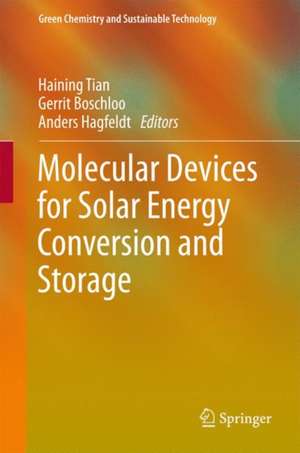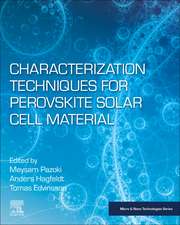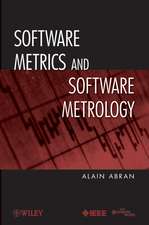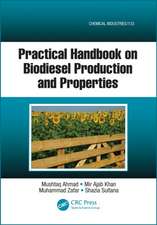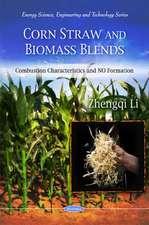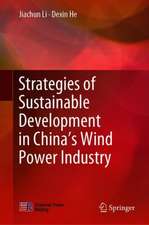Molecular Devices for Solar Energy Conversion and Storage: Green Chemistry and Sustainable Technology
Editat de Haining Tian, Gerrit Boschloo, Anders Hagfeldten Limba Engleză Hardback – 2 oct 2017
| Toate formatele și edițiile | Preț | Express |
|---|---|---|
| Paperback (1) | 1228.62 lei 6-8 săpt. | |
| Springer Nature Singapore – 14 feb 2019 | 1228.62 lei 6-8 săpt. | |
| Hardback (1) | 1234.94 lei 6-8 săpt. | |
| Springer Nature Singapore – 2 oct 2017 | 1234.94 lei 6-8 săpt. |
Din seria Green Chemistry and Sustainable Technology
- 15%
 Preț: 653.00 lei
Preț: 653.00 lei - 15%
 Preț: 648.24 lei
Preț: 648.24 lei - 18%
 Preț: 1127.28 lei
Preț: 1127.28 lei - 15%
 Preț: 697.32 lei
Preț: 697.32 lei - 15%
 Preț: 664.61 lei
Preț: 664.61 lei - 18%
 Preț: 1123.50 lei
Preț: 1123.50 lei - 18%
 Preț: 1407.46 lei
Preț: 1407.46 lei - 15%
 Preț: 649.39 lei
Preț: 649.39 lei - 18%
 Preț: 948.92 lei
Preț: 948.92 lei - 17%
 Preț: 394.87 lei
Preț: 394.87 lei - 15%
 Preț: 649.22 lei
Preț: 649.22 lei - 18%
 Preț: 1116.26 lei
Preț: 1116.26 lei - 15%
 Preț: 650.86 lei
Preț: 650.86 lei - 18%
 Preț: 1009.40 lei
Preț: 1009.40 lei - 15%
 Preț: 643.99 lei
Preț: 643.99 lei - 18%
 Preț: 1224.85 lei
Preț: 1224.85 lei - 18%
 Preț: 782.42 lei
Preț: 782.42 lei - 18%
 Preț: 995.34 lei
Preț: 995.34 lei - 24%
 Preț: 1060.04 lei
Preț: 1060.04 lei - 15%
 Preț: 641.03 lei
Preț: 641.03 lei - 15%
 Preț: 653.00 lei
Preț: 653.00 lei - 15%
 Preț: 659.35 lei
Preț: 659.35 lei - 18%
 Preț: 995.17 lei
Preț: 995.17 lei - 18%
 Preț: 1118.93 lei
Preț: 1118.93 lei - 15%
 Preț: 642.36 lei
Preț: 642.36 lei - 18%
 Preț: 955.08 lei
Preț: 955.08 lei - 15%
 Preț: 643.34 lei
Preț: 643.34 lei - 15%
 Preț: 653.14 lei
Preț: 653.14 lei - 18%
 Preț: 954.77 lei
Preț: 954.77 lei - 18%
 Preț: 1008.60 lei
Preț: 1008.60 lei - 15%
 Preț: 648.42 lei
Preț: 648.42 lei -
 Preț: 397.38 lei
Preț: 397.38 lei - 15%
 Preț: 651.84 lei
Preț: 651.84 lei
Preț: 1234.94 lei
Preț vechi: 1506.03 lei
-18% Nou
Puncte Express: 1852
Preț estimativ în valută:
236.36€ • 245.80$ • 197.78£
236.36€ • 245.80$ • 197.78£
Carte tipărită la comandă
Livrare economică 14-28 martie
Preluare comenzi: 021 569.72.76
Specificații
ISBN-13: 9789811059230
ISBN-10: 9811059233
Pagini: 531
Ilustrații: XIV, 531 p. 261 illus., 182 illus. in color.
Dimensiuni: 155 x 235 mm
Greutate: 0.94 kg
Ediția:1st ed. 2018
Editura: Springer Nature Singapore
Colecția Springer
Seria Green Chemistry and Sustainable Technology
Locul publicării:Singapore, Singapore
ISBN-10: 9811059233
Pagini: 531
Ilustrații: XIV, 531 p. 261 illus., 182 illus. in color.
Dimensiuni: 155 x 235 mm
Greutate: 0.94 kg
Ediția:1st ed. 2018
Editura: Springer Nature Singapore
Colecția Springer
Seria Green Chemistry and Sustainable Technology
Locul publicării:Singapore, Singapore
Cuprins
Small Molecule Solar Cells.- Polymer solar cells.- Liquid Dye Sensitized Solar Cells.- Solid-state dye-sensitized solar cells.- Hybrid organic/inorganic and perovskite solar cells.- Light-Driven Water-Splitting in the Dye Sensitized Photoelectrosynthesis Cell.- Light-driven carbon dioxide reduction devices.- Photobatteries and Photocapacitors.- Molecular Solar Thermal Energy Storage: Molecular Design and Functional Devices.- Impedance Spectroscopy in Molecular Devices.- Time-resolved laser spectroscopy in molecular devices for solar energy conversion.- X-ray Photoelectron Spectroscopy for Understanding Molecular and Hybrid Solar Cells.- Stability of Molecular Devices: Halide Perovskite Solar Cells.
Notă biografică
Haining Tian obtained his doctorate from Dalian University of Technology (China) in 2009. Then he joined Prof. Licheng Sun’s group as a postdoc/researcher in KTH Royal Institute of Technology, Sweden, from 2009-2014. During that period, he also spent two months as a visiting researcher at Universitat Jaume I, Spain. In 2014, he joined the Physical Chemistry department at Uppsala University as an assistant professor. In 2016, he became associate professor (Docent). His research interests mainly focus on molecular solar cells and solar fuel devices, particularly on functional organic/inorganic materials synthesis, photoelectrode fabrication, water splitting, carbon dioxide reduction and photosynthesis of organic chemicals. He has published over 50 peer-reviewed articles concentrating on molecular devices for solar energy conversion.
Gerrit Boschloo received his PhD in 1996 from Delft University of Technology, the Netherlands. He pursued postdoctoral research at University College Dublin, Ireland, and at Uppsala University, Sweden. After a research period at the Royal Institute of Technology (Stockholm, Sweden), he is currently an associate professor of Physical Chemistry at Uppsala University. His research focuses on photoelectrochemistry of semiconductors and molecular devices, specifically on dye-sensitized solar cells and perovskite solar cells. He has authored and coauthored over 160 peer-reviewed articles in leading journals.
Anders Hagfeldt is a professor of Physical Chemistry at EPFL, Switzerland. He obtained his Ph.D. at Uppsala University in 1993 and was a post-doc with Prof. Michael Grätzel (1993-1994) at EPFL, Switzerland. His research focuses on the mesoporous dye-sensitized solar cells, specifically on the physical and chemical characterization of mesoporous electrodes for different types of optoelectronic devices. He has published more than 400 scientific papers that have received over 40,000 citations (with an h-index of 100),and holds 8 patents. He was ranked number 46 on a list of the top 100 material scientists of the past decade by Times Higher Education. From 2014 to 2016 he was on Thomson Reuter’s list of Highly Cited Researchers, i.e. among the top 1% most cited in chemistry. He is a member of the Royal Swedish Academy of Sciences, European Academy of Sciences, Royal Society of Sciences in Uppsala, and the Royal Swedish Academy of Engineering Sciences. He is a visiting professor at Uppsala University, Sweden, and Nanyang Technological University, Singapore.
Gerrit Boschloo received his PhD in 1996 from Delft University of Technology, the Netherlands. He pursued postdoctoral research at University College Dublin, Ireland, and at Uppsala University, Sweden. After a research period at the Royal Institute of Technology (Stockholm, Sweden), he is currently an associate professor of Physical Chemistry at Uppsala University. His research focuses on photoelectrochemistry of semiconductors and molecular devices, specifically on dye-sensitized solar cells and perovskite solar cells. He has authored and coauthored over 160 peer-reviewed articles in leading journals.
Anders Hagfeldt is a professor of Physical Chemistry at EPFL, Switzerland. He obtained his Ph.D. at Uppsala University in 1993 and was a post-doc with Prof. Michael Grätzel (1993-1994) at EPFL, Switzerland. His research focuses on the mesoporous dye-sensitized solar cells, specifically on the physical and chemical characterization of mesoporous electrodes for different types of optoelectronic devices. He has published more than 400 scientific papers that have received over 40,000 citations (with an h-index of 100),and holds 8 patents. He was ranked number 46 on a list of the top 100 material scientists of the past decade by Times Higher Education. From 2014 to 2016 he was on Thomson Reuter’s list of Highly Cited Researchers, i.e. among the top 1% most cited in chemistry. He is a member of the Royal Swedish Academy of Sciences, European Academy of Sciences, Royal Society of Sciences in Uppsala, and the Royal Swedish Academy of Engineering Sciences. He is a visiting professor at Uppsala University, Sweden, and Nanyang Technological University, Singapore.
Textul de pe ultima copertă
This book shows the different molecular devices used for solar energy conversion and storage and the important characterization techniques for this kind of device. It has five chapters describing representative molecule-based solar cells, such as organic solar cells, dye-sensitized solar cells and hybrid solar cells (perovskite solar cell and quantum dots solar cells). It also includes two chapters demonstrating the use of molecular devices in the areas of solar fuel, water splitting and carbon dioxide reduction. There are further two chapters with interesting examples of solar energy storage related devices, like solar flow battery, solar capacitor and solar energy-thermal energy storage. Three chapters introduce important techniques used to characterize, investigate and evaluate the mechanism of molecular devices. The final chapter discusses the stability of perovskite solar cells. This book is relevant for a wide readership, and is particularly useful for students, researchers and industrial professionals who are working on molecular devices for solar energy utilization.
Caracteristici
Covers solar cells, solar fuels (water splitting/carbon dioxide reduction), solar flow batteries, solar capacitors, and solar energy-thermal energy techniques Demonstrates the working principle and molecule design of different molecular devices Introduces important techniques for the characterization and evaluation of the molecular devices Discusses the stability of perovskite solar cells
